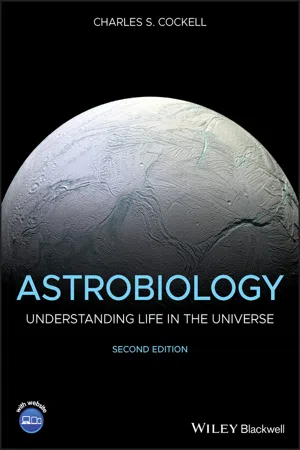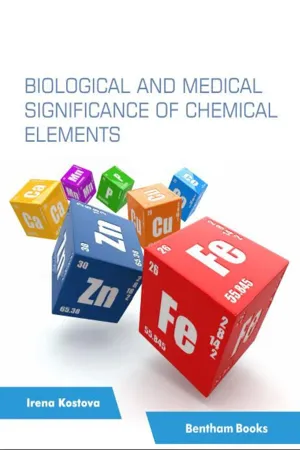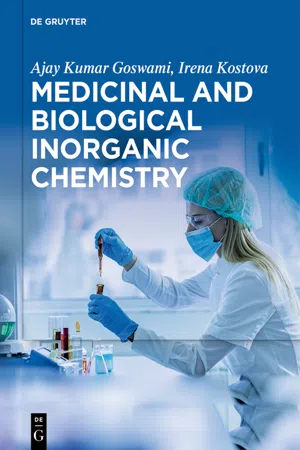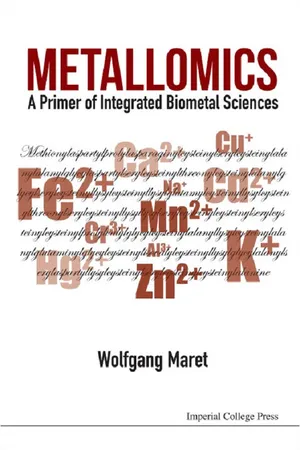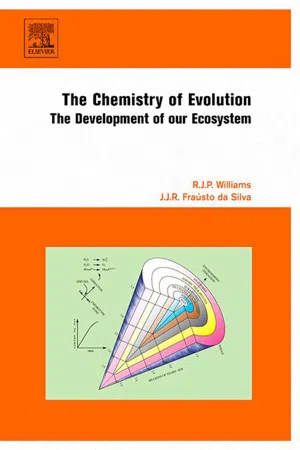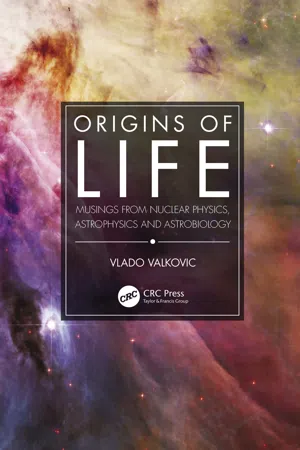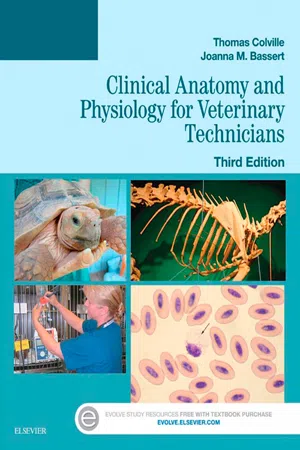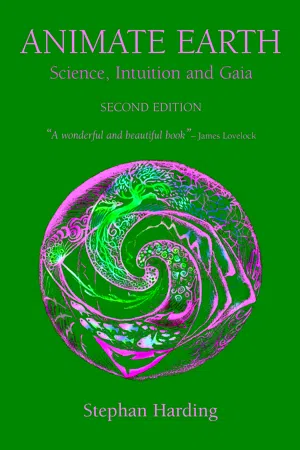Biological Sciences
Elements of Life
The "Elements of Life" refer to the essential chemical elements that are fundamental to biological processes. These elements include carbon, hydrogen, oxygen, nitrogen, phosphorus, and sulfur, which form the building blocks of biological molecules such as proteins, nucleic acids, and carbohydrates. Understanding the roles and interactions of these elements is crucial for comprehending the chemical basis of life.
Written by Perlego with AI-assistance
Related key terms
10 Key excerpts on "Elements of Life"
- eBook - ePub
- Ian Bradbury, John Boyle, Andy Morse(Authors)
- 2014(Publication Date)
- Routledge(Publisher)
32Life’s chemistry32.1 The chemical Elements of LifeOrganisms have made use of around one-quarter of the ninety or so naturally occurring chemical elements on the planet. Most of these elements are required by all organisms, but a few of them are required by some organisms and not by others. The elements, which are often called the nutrient elements, inorganic nutrients or bioelements , are shown in Table 32.1 , together with their chemical symbols.The list of elements in Table 3.1 reveals that all but four of the bioelements have an atomic number of 30 or less and comparatively low relative atomic masses. It thus appears that the size and mass of nuclei have been important factors in their appropriation for life processes. The chemical analysis of living tissue usually reveals the presence of a few other elements in addition to those listed. In the case of a plant, they may have been taken up by the roots, and in the case of an animal, consumed with the food. Some such elements, lead and cadmium for example, are toxic and may harm the organisms concerned, or those other organisms which feed upon them. Also, note that some of the essential elements, zinc and copper for example, are harmful if present in relatively high concentrations.32.2 CarbonThe chemistry of life is intimately associated with the chemistry of carbon compounds. (However, it should not be forgotten that some of the many other elements which organisms require are not necessarily always bound to organic molecules.) Carbon accounts for approximately 45 per cent of the dry mass of the Earth’s biota, although the percentage varies between different types of organism. Because carbon is so fundamental to life, the term ‘organic chemistry’ was coined early by chemists to distinguish this branch of the discipline from inorganic chemistry, which deals with all other compounds. However, large compounds containing carbon are produced synthetically, so organic chemistry is no longer solely concerned with the chemistry of life. We describe in more detail some general properties of carbon in 16 . Key points are that carbon atoms (atomic number 6), with four electrons in the valence shell, form stable bonds with each other, and these may be single, double or even triple bonds. The molecules so formed may be long chains (which may be branched or unbranched), they may be rings, or they may be more complex structures. Carbon also forms stable bonds with certain other elements, particularly oxygen (single and double bonds), hydrogen (single bonds), nitrogen (double and triple bonds) and sulphur (single bonds). The size of carbon compounds varies enormously. Some of the main ones that we consider contain just a few carbon atoms but others contain many thousands. In illustrating some of the more common compounds we use the conventions introduced when we discussed organic chemistry (see 16.3 - eBook - ePub
Astrobiology
Understanding Life in the Universe
- Charles S. Cockell(Author)
- 2020(Publication Date)
- Wiley-Blackwell(Publisher)
4 The Molecular Structure of LifeLearning Outcomes
- Understand that the basic elements required by life are carbon, hydrogen, nitrogen, oxygen, phosphorus, and sulfur (CHNOPS). Other elements are used for a range of functions specific to particular types of life.
- Understand why carbon is the most versatile backbone of molecules – life is “carbon-based.”
- Know the characteristics of the major classes of biological macromolecules: proteins, carbohydrates, lipids, and nucleic acids.
- Understand that some classes of molecules such as proteins and carbohydrates are chiral.
- Understand why water is the most versatile and plausible solvent for life.
- Understand some of the arguments for, and some of the limitations of, proposed alternative building block elements for life such as silicon, and alternative solvents such as ammonia.
4.1 Building Life
In Chapter 3 , we saw how different bonding types allow for the association of atoms, ions, and molecules. Life assembles these units, a bit like a construction kit, into macromolecules (large molecules), which themselves form the architecture of all cells from which life is assembled.In this chapter, we focus on the construction of living things from the atomic scale to this larger molecular scale. We explore some of the characteristics of the major groups of molecules that make up living things. We also identify and discuss common themes and principles that emerge about the construction of living things.4.2 The Essential Elements: CHNOPS
Building from the previous chapter, we could start with a very simple question: what is the minimum set of elements that life needs to assemble molecules? The matter from which life is constructed is unsurprisingly restricted to what is in the Periodic Table, and therefore its options are not unlimited.Furthermore, we can assume that the Periodic Table is universal. This seems a reasonable working assumption, as no astrophysicist has yet observed a place in the Universe that seems to have an entirely alien chemistry; in fact quite the contrary – as we shall see later, many elements of importance to life, such as carbon, seem to be surprisingly abundant throughout the Universe. Therefore, the observations we make about the chemistry of terrestrial life are likely to reveal important insights into the potential chemistry of life anywhere in the Universe. - Irena Kostova(Author)
- 2000(Publication Date)
- Bentham Science Publishers(Publisher)
Biogenic elements are required for life and their absence results in death. Of all elements of the periodic table, the ten metals - Na, K, Mg, Ca, Zn, Mn, Fe, Co, Mo, Cu and six organogens - H, C, N, O, P, and S, play a particularly important role in the implementation of various physiological and pathological processes and form the basis of all biologically important molecules and macromolecules. Currently, it is assumed that almost every one of the chemical elements of the periodic table plays some role in Earth's living systems and are found in living organisms, however, only around 25 elements are required by most, if not all, biological systems [ 3, 4 ]. Therefore, with the improvement of methods of determination, the knowledge of the presence of chemical elements in a living substance will expand. Chemical elements can be classified into two main groups: essential elements and non-essential elements. An element is considered essential when a lack of that element produces an impairment of function and the addition of the element restores the organism to a healthy state. Essentiality can be defined by the next criteria: physiological deficiencies arise when the element is removed from the diet; deficiencies are alleviated by the addition of this element to the diet; specific biological functions are related to that element [ 11 - 13 ]- eBook - ePub
- Ajay Kumar Goswami, Irena Kostova(Authors)
- 2022(Publication Date)
- De Gruyter(Publisher)
Section B Biological inorganic chemistryChapter 1 Introduction
Table 1.1 shows the relative distribution of the most important chemical elements in lithosphere, atmosphere, hydrosphere and biosphere.Table 1.1: Relative distribution of the most important chemical elements (%).Еlement Lithosphere Atmosphere Hydrosphere Biosphere O 61.1 21.1 33.2 24.9 Si 20.4 Al 6.3 H 2.9 66.2 49.7 Ca 2.1 Na 2.1 0.3 N 78.4 0.3 Ar 0.5 Cl 0.3 C 24.9 A living organism contains a wide variation of bioactive chemical elements, and their compounds assist the organisms’ functions and help animals and plants live healthy [1 –7 ]. The most important chemicals are mostly compounds that consist of combination of C, H and O atoms (organic compounds) with minor amounts of other chemical elements (Table 1.2 ). Of the known more than 100 elements, about 28% occur in the biological flora and fauna. It has to be mentioned that approximately most of the chemical elements of all groups are represented in biological materials though some of them are in trace amounts. The vital C in cooperation with N, H and O (the so-called major elements) are the most important for natural life, making up 96.3% of the weight of the body. The lasting 3.7% contain only seven additional chemical elements (Table 1.2 ), which are in trace amounts in many living organisms and can also be considered as essential for life. The group of minor elements consist of calcium, phosphorus, potassium, sulphur, sodium, chlorine and magnesium. - eBook - ePub
Symphony in C
Carbon and the Evolution of (Almost) Everything
- Robert Hazen(Author)
- 2019(Publication Date)
- William Collins(Publisher)
For a chemical element to be central to life’s origins, it must conform to a few basic expectations. Without question, any element essential to life has to be reasonably abundant, widely available in Earth’s crust, oceans, and atmosphere. The element has to have the potential to undergo lots of chemical reactions; it can’t be so inert that it just sits there doing nothing. On the other hand, life’s core element can’t be too reactive; it can’t burst into flame or explode at the slightest chemical provocation.And even if an element finds itself at a happy medium of chemical reactivity, in that ideal realm between explosive and dead, it must do more than just one chemical trick. It must be adept at forming sturdy and stable structural membranes and fibers—the bricks and mortar of life. It must be able to store, copy, and interpret information. And that special element, in combination with other ubiquitous elemental construction materials, must find a way to harness energy from combinations of other chemicals or perhaps the Sun’s abundant light. Clever combinations of elements must store that energy in convenient chemical form like a battery, and then release controlled pulses of energy whenever and wherever it is needed. The essential element of life has to multitask.In that restrictive context, consider the many elemental alternatives. The most common elements in the Cosmos are hydrogen and helium, the first and second occupants of the periodic table—the entire upper row—but they would never do as the foundation of a biosphere.Hydrogen, which can bond strongly to only one other atom at a time, fails the versatility test. Hydrogen is not unimportant, mind you. It helps to shape many of life’s molecules through “hydrogen bonding”—a kind of molecular glue—while it plays a vital co-starring role with oxygen in water, the medium of all known life-forms. But Element 1 cannot provide the versatile chemical foundation for life. - eBook - ePub
Metallomics
A Primer of Integrated Biometal Sciences
- Wolfgang Maret(Author)
- 2016(Publication Date)
- WSPC(Publisher)
The way such biological PSEs are usually presented generates considerable confusion due to at least three issues. First, the essential elements are given without reference to a specific form of life. Instead, what is presented is the sum of all elements essential for life despite the fact that the number of essential elements differs in organisms. Second, a clear definition is lacking what “essential” actually means, an issue that is discussed in the next chapter. Moreover, the relative biological significance of the elements is not apparent from such a presentation. Elements with critical general functions are mixed with those that have only very specific functions. Third and remarkably, it is often overlooked that many more metals and elements than just the essential ones are present in organisms and that their presence is often associated with functional outcomes (Table 3.2 ; Haraguchi et al. 2008; Roverso et al. 2015; Emsley 2001). Determining elements in biological material, of course, is a matter of sensitivity of the methods — an increasing number of elements can be found with increasing sensitivity. Organisms have the capability of metabolising, i.e. chemically modifying elements and their species, which is not evidence by itself for these elements having an essential function. For example, bacteria methylate mercury compounds and organisms synthesize arsenic-containing sugars and lipids. Such reactions are also part of the inorganic biochemistry of life. It is instructive to collect the information about the abundance of elements in humans in the PSE (Figure 3.11). Nobel laureate Francis William Aston (1877–1945) determined the abundance of the elements on earth and found that it decreases with increasing atomic number. It is therefore not surprising to find that most of the abundant elements are employed in life with the notable exception of aluminium. On the other hand, some elements that are quite rare, e.g - eBook - ePub
The Chemistry of Evolution
The Development of our Ecosystem
- R.J.P Williams, J.J.R Fraústo da Silva(Authors)
- 2005(Publication Date)
- Elsevier Science(Publisher)
There is one general way of introducing chemical energy into synthesis and use of it in pumps which is to transduce any environmental source to pyrophosphate. Once again is this a uniquely suitable route?The probability of life emerging is, of course, unknown and perhaps unknowable. It is extremely unlikely in a very local part of the universe but may be high overall. Any judgement here is exceedingly speculative. The safe starting point is that the life we know on the Earth is based on the above particular mix of nonmetal, in organic chemicals, and metal elements which arose by the very nature of the Earth, but this mix would be inadequate unless energised, limited in space and with its reactions organised (see Section 3.7 ). Given the changing conditions of Earth’s chemistry and that it was energised later by the Sun (Chapter 1 ), and our general hypothesis of how energy-capturing systems change (Section 3.8 ), we have to consider how life would progress towards optimal energy capture. First, we must look at the value of the original available elements which were taken into or rejected by organisms. Afterwards, we shall look at the way the originally available elements could form the essential compounds we observe in all life (Table 4.4 ); then we must ask about organisation. (see Section 4.20 ).Table 4.4 Components in a Typical Simple (Bacterial) CellComponent Numbers Variety Proteins (proteome) 2.5×106 3,000 DNA (genome) 1(2) 1 m-RNA 4,000 2,000 Ribosomes > 10,000 2 Peptidoglycan 1 1 (wall) Metabolites (metabolome) 3×108 103 Lipid 2×106 2? Water 5×1010 1 Metal ions (metallome) 107 12 Note: See Harold in Further Reading for data on E . coli .4.4 The Functional Value of the Elements in Organisms: Introduction to Biological Compounds
We turn now to the essential ways the elements are used in biological chemistry. Rather than taking all the elements together, we shall look at two sets of them separately – the non-metals and the metals – indicating the common types of compound in which they are found in all cells. This separation makes a clear connection to the description of the chemistry of the elements in Chapter 2 . We shall see that their conditions are energised in different ways. We shall look at these compounds and their use in cells while asking whether or not there is likely to be equilibrium between their binding sites within any aqueous compartment, also across membranes and even with their small ion or molecular states as found in the environment. This is a considerable concern in thermodynamics (see Section 3.14 ). The parallels with the different chemistry of non-metals and metals (in organic and inorganic chemistry) as introduced in Chapter 2 - eBook - ePub
Origins of Life
Musings from Nuclear Physics, Astrophysics and Astrobiology
- Vlado Valkovic(Author)
- 2021(Publication Date)
- CRC Press(Publisher)
Lipids do not dissolve in water. They have long sections of non-polar carbon–hydrogen bonds. When placed in water, lipid molecules form clusters with polar parts facing toward the exterior and non-polar portions toward the interior (away from water). Lipids include (i) triglycerides (dense energy storage built in fat cells), (ii) phospholipids (structural component of the cell membrane phospholipid bilayer), (iii) steroids (e.g., cholesterol) and (iv) waxes (for waterproofing). Proteins perform the chemistry of cells. Proteins are made of chains of amino acids that may interact and fold over each other to form different shapes and structures. Protein functions include structural support, enzymes for reactions, transport of other molecules, storage, signaling, movement in the organism and immune defense. Nucleic acids store and transfer genetic information. Nucleic acids are composed of sugar, a phosphate group and a nitrogen base. The two major types of nucleic acids are deoxyribonucleic acid (DNA) and ribonucleic acid (RNA). DNA and RNA sequences are a code for the inherited traits of an organism.Recently, mathematicians and physicists have an increased interest in biochemistry. Some of these efforts are described in the book by Stcherbic and Buchatsky (2015 ). Their book provides a review of biochemistry as an algebra of molecules of living matter. It utilizes Clifford algebras to discuss the underlying biochemical processes of DNA replication, DNA transcription, RNA splicing and translation. Specifically, viral carcinogenesis is defined by the structural features that are used to identify a particular Clifford algebra. Useful examples of the transformation of genetic information into Clifford algebras are provided.4.2 Elemental Composition of Living Matter
The organic cycle includes eleven elements: H, C, N, O, Na, Mg, P, S, Cl, K and Ca, which form the bulk of the living matter. They all have very low atomic weights, and they belong to the lowest 20 elements of the periodic table. These elements are also the most abundant in the Universe. The only nonessential light elements, with the exclusion of noble gases, are Li, Be, B (boron is essential for some plants) and maybe Al. Also, some elements have been recognized as essential trace elements. For example, essential trace elements for warm-blooded animals are F, Si, V, Cr, Mo, Fe, Co, Ni, Cu, Zn, Se, Mo, Sn, I and W. For the most part, the essential trace elements are transition metals with unfilled d-orbital. None of the 39 elements beyond tungsten (Z = 74) has ever been shown to have any physiological significance.The so-called bulk elements oxygen, carbon, hydrogen and nitrogen make up (96.8% ± 0.1%) of the mass of living matter, while phosphorus and sulfur make up (1.0% ± 0.3%). The amount of (2.2% ± 0.2%) is dominated by potassium, sodium, calcium, magnesium and chlorine, while the remaining mass of (0.03% ± 0.01%) is attributed to “trace” elements such as iron, copper and cobalt. These values, reported in Chopra and Lineweaver (2009 ), were derived from the averaged elemental abundances in humans and bacteria, as presented in Snyder et al. (1975) and Porter (1946 - Thomas P. Colville, Joanna M. Bassert(Authors)
- 2015(Publication Date)
- Mosby(Publisher)
Table 2-1 shows the most common elements found in living organisms and their function in the body. These are divided into major and minor categories.TABLE 2-1 Elements in the Animal BodyThe Percentage of Each Element Found in an Animal's Body is Listed. Note That the First Few Elements Make Up the Vast Majority of Matter in the Animal BodyELEMENT CHEMICAL SYMBOL ATOMIC NUMBER BODY MASS (%) FUNCTION IN THE ANIMAL BODY Major Elements Oxygen O 8 65.0 Necessary for cellular respiration; component of water Carbon C 6 18.5 Primary component of organic molecules Hydrogen H 1 9.5 Component of water and organic molecules; necessary for energy transfer and respiration; ion influences pH of fluids Nitrogen N 7 3.3 Component of all proteins and nucleic acids Calcium Ca 20 1.5 Component of bones and teeth; required for muscle contraction, nerve impulse transmission, and blood clotting Phosphorus P 15 1.0 Principal component in backbone of nucleic acids; important in energy transfer (part of ATP); component of bones Potassium K 19 0.4 Principal positive ion within cells; important in nerve function Sulfur S 16 0.3 Component of most proteins Sodium Na 11 0.2 Important positive ion in extracellular fluid; important in nerve function Chlorine Cl 17 0.2 Ion is most abundant negative ion in extracellular fluids Magnesium Mg 12 0.1 Component of many energy-transferring enzymes Trace Elements Silicone Si 14 0.1 Component of some enzymes Aluminum Al 13 0.1 Component of some enzymes Iron Fe 26 0.1 Critical component of hemoglobin Manganese Mn 25 0.1 Needed for fatty acid synthesis Fluorine F 9 0.1 Component of bones and teeth Vanadium V 23 0.1 Component of some enzymes Chromium Cr 24 0.1 Needed for proper glucose metabolism Copper Cu 29 0.1 Needed for hemoglobin and myelin Boron - eBook - ePub
Animate Earth
Science, Intuition and Gaia - A New Scientific Story
- Stephen Harding(Author)
- 2011(Publication Date)
- Green Books(Publisher)
Chapter 4 Life and the Elements Atoms as BeingsIn order to deeply understand the life of our planet we need to explore the cycles of the chemical elements, for without their coming to life in organisms there would be no Gaia to speak of. So what exactly are the chemical elements? Democritus was right—the material world is indeed made of atoms, but, as we have seen, atoms are not dead, mechanical entities; they are participatory beings with characters akin to our own, even though those of atoms are far more consistent than human nature, which is malleable, often unpredictable, and very much dependent on circumstance. Place the same person in the same environment today and tomorrow, and on one day they may feel good, on the other they may feel sad. According to mainstream science, atomic personalities are far more consistent—an oxygen atom will always behave in the same way whenever it encounters the same chemical and physical environment, no matter where in the universe the encounter happens. Every person (and indeed, every mammal, bird, reptile, and possibly insect) has a unique character— no two hummingbirds will behave in exactly the same way, but every oxygen atom is considered to have exactly the same response, the same character everywhere throughout the universe.This does not mean that atoms, or the protons, neutrons and electrons that constitute them, are no more than totally isolated, independent, selfexisting entities interacting like billiard balls in totally predictable ways. Modern physics shows us that nothing in the universe exists in splendid isolation—everything depends for its very existence on its relationships with everything else. When a hydrogen atom bonds with an oxygen atom, aspects of the personalities of hydrogen and oxygen are brought out in the relationship which are not present in oxygen and hydrogen alone. This particular combination, known as the hydroxyl ion, is gaseous at ambient temperature, and is extremely good at scrubbing pollutants out of the atmosphere. However, when two hydrogen atoms bond with an oxygen atom, a totally different set of qualities spring forth in a new emergent domain with all the extraordinary and life-giving properties of water with which we are all so familiar. So atoms have freedom, but far less freedom than us. If we think of matter in this way, we can draw two important conclusions. Firstly, it no longer seems to be such a stretch to imagine that the many little ‘freedoms’ in matter can produce the high level of freedom that is so much a part of human consciousness. In the words of philosopher J. McDaniel, “Our own subjective experiences are highly developed forms of what there was in the beginning in sub-microscopic matter”, and “‘Matter’ and ‘mind’ are simply names for different types of actual occasions of experience.” In the words of philosopher Christian De Quincey, “Matter tingles with experience” and “Matter feels to its deepest roots.” Secondly, we can no longer treat matter with disrespect, because it is, after all, sentient in some sense by virtue of having a creative agency and capacity for experience that demands our ethical consideration. We realise the profound wisdom in the etymological root of the word ‘matter’, which comes form the Latin for ‘mother’ (mater
Learn about this page
Index pages curate the most relevant extracts from our library of academic textbooks. They’ve been created using an in-house natural language model (NLM), each adding context and meaning to key research topics.

